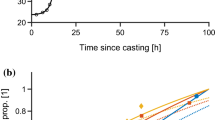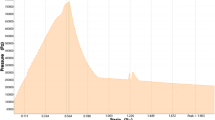Abstract
The long-term behavior and safety performance of hydraulic concrete structures are influenced by chemo-mechanical deterioration due to leaching and frost. The single-scale experimental investigations on the certain deterioration phenomenon of concrete structure submitted to leaching or frost have been performed. In this work, the multi-scale numerical simulation approach is introduced to analyze the deterioration phenomena due to leaching or/and frost in hydraulic concrete and the structural responses to the above deterioration phenomena. The three-dimensional (3D) multi-scale modeling and homogenization methods of hydraulic concrete submitted to leaching or/and frost are developed. The effect analysis of leaching or/and frost on the mechanical properties of hydraulic concrete is implemented. First, according to the multi-scale and multi-phase characteristics of hydraulic concrete as composite material, the scale separation standard of hydraulic concrete is given. The hydration model and random aggregate model are introduced to reconstruct the representative volume element model of hydraulic concrete with different scales, namely micro-scale (cement paste), meso-scale (mortar), macro-scale (concrete). The numerical homogenization method is presented to determine the mechanical properties of the hydraulic concrete. Second, the methods are developed to implement the 3D multi-scale simulation for random leaching process and thermo-mechanical coupling frost damage process of hydraulic concrete. Regarding seepage leaching as the leading role, a numerical method investigating the combined effect of leaching and frost on the mechanical properties of hydraulic concrete is proposed. Finally, the water-saturated hydraulic concrete is taken as an example. The deterioration phenomena due to leaching or/and frost in selected concrete are analyzed. The structural responses to the above deterioration phenomena are identified. It is indicated that the proposed multi-scale progressive analysis approach can capture the potential deterioration phenomena of hydraulic concrete. The variation mechanism of concrete structural behavior can be given a deeper insight. It can be seen that the nonlinear superimposed effect of leaching and frost can easily cause serious damage of water-saturated hydraulic concrete.






















Similar content being viewed by others
References
Su HZ, Hu J, Wen ZP (2013) Service life predicting of dam systems with correlated failure modes. J Perform Constr Fac 27(3):252–269
Wu ZR, Li J, Gu CS, Su HZ (2007) Review on hidden trouble detection and health diagnosis of hydraulic concrete structures. Sci China Technol Sc 50(1):34–50
Durcheva VN, Puchkova SM (1995) Main causes, signs, and consequences of aging of concrete dams. Hydrotech Constr 29(2):9–10
Liu HZ, Zhang Q, Li V, Su HZ, Gu CS (2017) Durability study on engineered cementitious composites (ECC) under sulfate and chloride environment. Constr Build Mater 133:171–181
Grattan-Bellew PE (1996) Microstructural investigation of deteriorated Portland cement concretes. Constr Build Mater 10(1):3–16
Buffo-Lacarrière L, Sellier A (2011) Chemo-mechanical modeling requirements for the assessment of concrete structure service life. J Eng Mech 137(9):625–633
Shayan A, Grimstad J (2006) Deterioration of concrete in a hydroelectric concrete gravity dam and its characterization. Cement Concrete Res 36(2):371–383
Timothy P, Dolen PE (2004) Materials properties model of aging concrete. USBR
Guthrie GD, Carey JW (2015) A thermodynamic and kinetic model for paste–aggregate interactions and the alkali-silica reaction. Cement Concrete Res 76:107–120
Sanchez LFM, Multon S, Sellier A, Cyr M, Fournier B, Jolin M (2014) Comparative study of a chemo–mechanical modeling for alkali silica reaction (ASR) with experimental evidences. Constr Build Mater 72:301–315
Zhang C, Sorelli L, Fournier B, Duchesne J, Bastien J, Chen Z (2017) Stress-relaxation of crystalline alkali-silica reaction products: characterization by micro- and nanoindentation and simplified modeling. Constr Build Mater 148:455–464
Su HZ, Hu J, Tong JJ, Wen ZP (2012) Rate effect on mechanical properties of hydraulic concrete flexural-tensile specimens under low loading rates using acoustic emission technique. Ultrasonics 52(7):890–904
Nguyen VH, Colina H, Torrenti JM, Boulay C, Nedjar B (2007) Chemo-mechanical coupling behaviour of leached concrete Part I: Experimental results. Nucl Eng Des 237(20–21):2083–2089
Nguyen VH, Nedjar B, Torrenti JM (2007) Chemo-mechanical coupling behaviour of leached concrete Part II: Modelling. Nucl Eng Des 237(20–21):2090–2097
Yang ZF (2004). Assessing cumulative damage in concrete and quantifying its influence on life cycle performance modeling. Purdue University
Nguyen VP, Lloberas-Valls O, Stroeven M, Sluys LJ (2011) Homogenization based multiscale crack modelling: From micro-diffusive damage to macro-cracks. Comput Method Appl M 200(9–12):1220–1236
Har N, Bindiu R, Gorea M, Benea M (2007) Mineralogical aspects concerning degradation of some concrete and mortars. Rev Rom Mater 37(3):228–238
Garas VY, Jayapalan AR, Kahn LF, Kurtis KE (2010) Micro- and Nanoscale characterization of effect of interfacial transition zone on tensile creep of ultra-high-performance concrete. Transport Res Rec 2141:82–88
Bernard F, Kamali-Bernard S (2010) Performance simulation and quantitative analysis of cement-based materials subjected to leaching. Comp Mater Sci 50(1):218–226
Kamali-Bernard S, Bernard F (2011) How to assess the long-term behaviour of a mortar submitted to leaching. Eur J Environ Civ En 15(7):1031–1043
Hain M, Wriggers P (2008) Computational homogenization of micro-structural damage due to frost in hardened cement paste. Finite Elem Anal Des 44:233–244
Hain M (2007) Computational homogenization of micro-structural damage due to frost in hardened cement paste. Leibniz-University of Hannover
Nguyen VP, Lambertus MS, Sluys LJ (2012) Multiscale failure modeling of concrete: Micromechanical modeling, discontinuous homogenization and parallel computations. Comput Method Appl M 201–204:139–156
Bentz DP (2006) Quantitative comparison of real and CEMHYD3D model microstructures using correlation functions. Cement Concrete Res 36:259–263
Bentz DP (2005) CEMHYD3D: a three-dimensional cement hydration and microstructure development modeling package. Version 3.0. National Institute of Standards and Technology Interagency, U.S. Department of Commerce
Bernard O, Ulm FJ, Lemarchand E (2003) A multiscale micromechanics-hydration model for the early-age elastic properties of cement-based materials. Cement Concrete Res 33:1293–1309
Rosenqvist M, Fridh K, Hassanzadeh M (2012) Macroscopic ice lens growth: observations on Swedish concrete dams. 3rd International Conference on Concrete Repair, Rehabilitation and Retrofitting, Cape Town
Kruis J, Koudelka T, Krejci T (2012) Multi-physics analyses of selected civil engineering concrete structures. Commun Comput Phys 12:885–918
Kuhl D, Bangert F, Meschke G (2004) Coupled chemo-mechanical deterioration of cementitious materials. Part I: Modeling. Int J Solids Struct 4:15–40
Li JY, Xu WY, Cao JG (1999) Study on the mechanism of concrete destruction under frost action. J Hydraul Eng (1):41–49
Bentz DP, Garboczi EJ (1992) Modelling the leaching of calcium hydroxide from cement paste: effects on pore space percolation and diffusivity. Mater Struct 25(9):523–533
Temizer I, Wu T, Wriggers P (2013) On the optimality of the window method in computational homogenization. Int J Eng Sci 64:66–73
Acknowledgements
This research has been partially supported by National Natural Science Foundation of China (SN: 51579083, 51739003, 51479054, 41323001), the National Key Research and Development Program of China (SN: 2016YFC0401601), Open Foundation of State Key Laboratory of Hydrology-Water Resources and Hydraulic Engineering (SN: 20165042112, 20145027612), the Fundamental Research Funds for the Central Universities (Grant no. 2015B25414).
Author information
Authors and Affiliations
Corresponding author
Rights and permissions
About this article
Cite this article
Su, H., Hu, J. & Li, H. Multi-scale performance simulation and effect analysis for hydraulic concrete submitted to leaching and frost. Engineering with Computers 34, 821–842 (2018). https://doi.org/10.1007/s00366-018-0575-9
Received:
Accepted:
Published:
Issue Date:
DOI: https://doi.org/10.1007/s00366-018-0575-9




